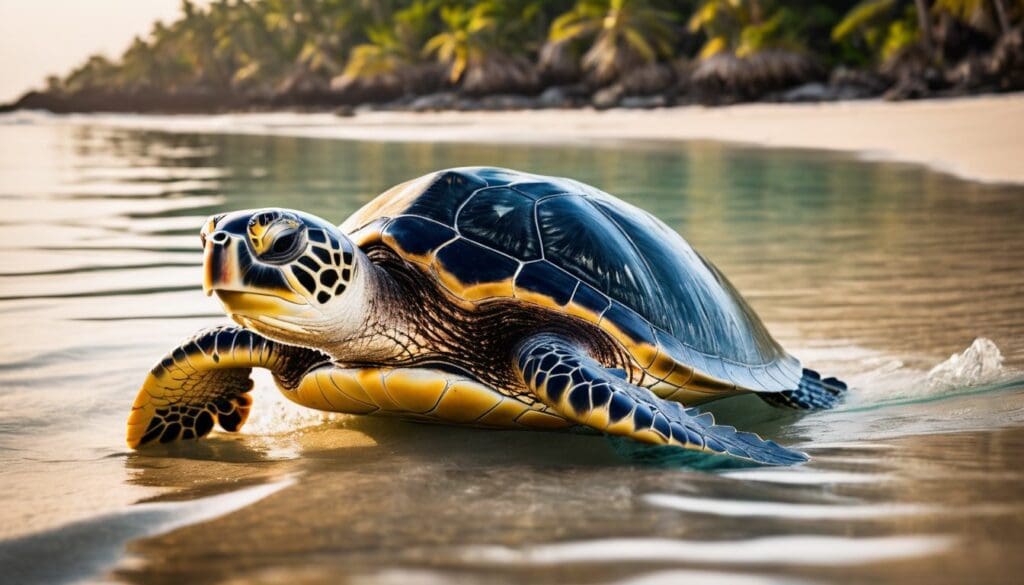We’ve all been caught up in the sheer awe that washes over us when we hear tales of the ancient, nomadic voyages undertaken by sea turtles across vast oceans. Much like ourselves, there’s an innate curiosity to delve deeper into the lives of these elusive creatures; it’s quite extraordinary to think that some species embark on epic journeys spanning over 10,000 kilometres during their migration.
Our forthcoming article gently unravels the secrets enshrouded within these noble animals, shining a light on their existence and underscoring their pivotal role in the well-being of our blue planet.
Do join us as we plunge into the deep blue to explore a world beyond our reach!
Key Takeaways
- Sea turtles use the Earth’s magnetic field like a GPS to navigate back to their birthplace for nesting, demonstrating exceptional natural navigational skills.
- They face numerous threats from human activities such as poaching, pollution, and climate change which disrupt their habitats and endanger their survival.
- Conservation efforts include protecting nesting sites, developing turtle – friendly fishing gear to prevent bycatch, and reducing pollution in oceans.
- Research using satellite tracking and genetic studies enhances our understanding of sea turtles’ migratory patterns and behaviour, aiding in effective conservation strategies.
- Sea turtles hold cultural significance across various societies worldwide; education initiatives raise awareness about the importance of protecting these ancient ocean travelers.
Anatomy and Evolution of Sea Turtles
Sea turtles have unique super senses, astonishing navigational skills, and a connection to snakes and turtles. Their evolution has equipped them with incredible abilities that make them fascinating creatures of the ocean.
Unique super senses
Sea turtles possess incredible sensory abilities that often seem like superpowers. Their eyes can detect light wavelengths allowing them to see well in murky ocean depths where sunlight barely reaches.
Even more impressive, they have a heightened sense of smell underwater, guiding them to food across vast distances. We know these oceangoing reptiles rely on their keen perception for survival, navigating through the open sea with what seems like an internal compass.
These animals also surprise us with their sensitivity to Earth’s magnetic field; it’s how they accomplish extraordinary feats of navigation during migration. They use this magnetic sensitivity, almost like a built-in GPS, to return to the very beaches where they hatched years earlier to nest themselves.
We marvel at the precision and reliability of this system and acknowledge its importance for the conservation of endangered sea turtles. By understanding and protecting these unique super senses, we help safeguard not just individual turtles but entire marine ecosystems vital for global biodiversity.
Astonishing navigational skills
Sea turtles possess astonishing navigational skills that enable them to travel thousands of miles across the ocean, returning to the exact beach where they were born to nest. Using Earth’s magnetic field as a guide, these incredible creatures are able to navigate with precision through vast expanses of open water.
Loggerhead sea turtles, for example, have been observed navigating across the entire North Atlantic Ocean and back using their innate ability to detect changes in the Earth’s magnetic field.
Such remarkable navigational abilities contribute to their survival and play a vital role in maintaining healthy sea turtle populations.
Connection to snakes and turtles
Sea turtles have an intriguing link to snakes and turtles, as all three are reptiles. Despite their different habitats – land for turtles, oceans for sea turtles, and varying degrees of both for snakes – they share common ancestry and evolutionary traits.
For instance, studies show that sea turtles’ internal organs are similar to those of other reptiles like snakes and land-dwelling tortoises. Additionally, the way these animals move through water or on solid ground displays biological similarities.
The connection between sea turtles, snakes, and tortoises provides valuable insight into the evolution and adaptation of reptiles across diverse ecosystems. By studying these connections, researchers can enhance their understanding of how environmental changes impact various species within the reptilian family tree.
Diversity and Behavior of Sea Turtles
Sea turtles come in various species, each with its own unique behaviors and habits. From the gentle green sea turtle to the powerful leatherback, these creatures play different roles in the marine ecosystem and have fascinating reproduction habits that are crucial for their survival.
Different species
- The green sea turtle, known for its herbivorous diet and stunningly coloured shell.
- The hawksbill sea turtle, which plays a crucial role in coral reef ecosystems due to its diet of sponges and other invertebrates.
- The loggerhead sea turtle, recognised for its large head and powerful jaws.
- The olive ridley sea turtle, distinguished by its heart-shaped shell and remarkable mass nesting events known as arribadas.
- The flatback sea turtle, found solely in the waters around Australia, Papua New Guinea, and Indonesia.
Reproduction habits
- Mating rituals: Male sea turtles use their flippers to grasp the female during mating, whilst some species perform elaborate courtship displays.
- Nesting behaviour: Female sea turtles return to the beaches where they were born to lay eggs in carefully crafted nests dug with their hind flippers.
- Egg laying: They deposit and cover dozens of eggs before returning to the sea, leaving the eggs to incubate for about two months.
- Hatching and emergence: Once ready, hatchlings break free from the shells and emerge from the sand en masse, making their way to the ocean guided by natural cues.
Role in the food web
After nesting on beaches, sea turtles play a crucial role in the food web of marine ecosystems. As they venture into the ocean, juvenile and adult sea turtles help control jellyfish populations by feeding on them.
Additionally, their foraging behavior helps to maintain the health of seagrass beds and coral reefs, contributing to balanced coastal ecosystems. When adult sea turtles migrate long distances, they transport essential nutrients from one area to another, supporting the diversity of marine life along their routes.
Sea turtle predation also indirectly influences the abundance and distribution of other species within their habitats. By doing so, they contribute significantly to maintaining the ecological balance of ocean environments.
Human Impacts on Sea Turtles
The human impact on sea turtles is substantial, ranging from poaching and hunting to pollution and climate change. To learn more about how these impacts are affecting the majestic sea turtle population, keep reading.
Poaching and hunting
Poaching and hunting pose significant threats to sea turtles, leading to a decline in their population. Illegal activities such as harvesting turtle eggs for consumption or making products from their shells contribute to the depletion of these ancient creatures.
Additionally, commercial fishing operations often inadvertently catch sea turtles in their nets and longlines, further endangering their survival. It is vital for us to actively support initiatives that combat poaching and illegal trade of sea turtles and advocate for stricter regulations to protect these majestic marine animals.
To address the threat of poaching and hunting on sea turtle populations, we need collaborative efforts involving communities, governments, and conservation organisations. By raising awareness about the importance of preserving sea turtles and enforcing laws against illegal exploitation, we can safeguard the future of these magnificent creatures while promoting biodiversity within our oceans.
Entanglement and bycatch
Sea turtles face a significant threat from entanglement in fishing gear and bycatch. Fishing nets, lines, and traps often ensnare sea turtles while they are foraging for food or during migration, leading to injury or death.
This unintentional capture of sea turtles as bycatch in commercial fishing operations also poses a severe risk to their populations, especially when combined with other threats such as pollution and climate change.
By actively engaging in sustainable fishing practices and supporting initiatives that promote the use of turtle-friendly gear, we can help reduce the incidence of entanglement and bycatch.
Additionally, advocating for the implementation of regulations that protect sea turtle habitats and minimise interactions with fishing activities is crucial for their conservation.
Pollution
Pollution poses a significant threat to sea turtles as they navigate and inhabit the world’s oceans. Plastics, chemicals, and other pollutants harm these creatures when mistaken for food or when they become entangled in debris.
The degradation of nesting sites due to pollution also affects their ability to reproduce successfully. Oil spills and toxic runoff further deteriorate their habitats, making it challenging for sea turtles to thrive.
Our efforts towards reducing pollution can greatly benefit sea turtle populations. By promoting sustainable practices, we can limit the amount of harmful substances that enter the oceans.
Beach development
Beach development threatens sea turtles by destroying nesting sites and disrupting their natural habitat. Coastal construction, including hotels, resorts, and residential buildings, can lead to light pollution on beaches which confuses hatchlings as they mistake artificial lights for the moon or stars.
Moreover, beachfront developments often result in increased human activity that disturbs nesting females and deters them from laying eggs. Without intervention to protect these critical habitats, the future of sea turtles remains uncertain.
Irresponsible urbanisation along coastlines contributes to a range of negative impacts on sea turtle populations such as obstructed access to the ocean for hatchlings due to structures like seawalls, and erosion caused by improper land use practices exacerbate the destruction of nests.
Climate change
Climate change poses a significant threat to sea turtles, impacting their nesting sites and the temperature of their habitats. Rising global temperatures can lead to an imbalance in the male-to-female ratio of turtle hatchlings due to the relationship between temperature and gender.
Additionally, climate change contributes to extreme weather events that erode nesting beaches, making it more challenging for sea turtles to lay their eggs. The increase in ocean acidification also affects the food sources of these majestic creatures, further jeopardising their survival.
Furthermore, as ocean temperatures continue to rise, it disrupts the delicate balance of marine ecosystems where sea turtles reside. This disruption affects not only the availability of prey for sea turtles but also exacerbates existing threats such as pollution and habitat loss.
Research and Technology
Tracking and studying sea turtles through advanced technology, such as satellite tags and tracking devices, helps us better understand their movements and habitats.
To learn more about the incredible world of sea turtles, continue reading our blog on the mystery and majesty of these fascinating creatures.
Tracking and studying sea turtles
Studying sea turtles provides invaluable insights into their behaviour and migration patterns. This knowledge is crucial for effective conservation efforts.
- Utilising satellite tracking, scientists follow the migratory routes of sea turtles to better understand their movements and identify important feeding and nesting areas.
- Researchers also employ acoustic tagging to study the underwater behaviour of sea turtles, including their diving patterns and foraging habits.
- Genetic studies help in identifying populations and understanding the connectivity between different nesting sites, which is vital for effective conservation management.
- By analysing biotelemetry data, scientists can assess the impact of human activities such as fishing and boat traffic on sea turtle populations.
- Collaborative research projects involving local communities are essential for gathering traditional ecological knowledge about sea turtles, which aids in developing culturally sensitive conservation strategies.
- Technology such as drones assists in monitoring sea turtle nesting sites, providing valuable data that contributes to their protection.
- Engaging citizen scientists in monitoring programmes enhances our understanding of sea turtle ecology while promoting public awareness and involvement in their conservation.
Conservation efforts
Sea turtles need our help to survive and thrive. Here are some impactful conservation efforts that we can support:
- Implementing regulations to reduce poaching and hunting, protecting nesting sites, and enforcing laws against the illegal trade of sea turtle products.
- Developing innovative fishing gear and techniques to minimise entanglement and bycatch, protecting sea turtles from accidental harm.
- Collaborating with coastal communities and industries to reduce pollution in marine habitats, ensuring cleaner environments for sea turtles to thrive.
- Advocating for responsible beach development practices that preserve crucial nesting grounds for sea turtles.
- Contributing to research on the impacts of climate change on sea turtle populations, and supporting initiatives aimed at mitigating these effects.
- Educating local communities about the ecological importance of sea turtles, fostering a culture of respect and stewardship towards these magnificent creatures.
- Supporting wildlife preservation organisations that work tirelessly to protect endangered species like sea turtles through rehabilitation, release programmes, and habitat conservation initiatives.
Cultural Connections and Education
Sea turtles have significant cultural connections in many societies and efforts are being made to raise awareness about their conservation. To find out more about the cultural significance of sea turtles and the education initiatives surrounding them, continue reading our blog!
Significance in different cultures
Sea turtles have significant cultural relevance in many communities worldwide, reflecting their enduring presence and impact on human societies. Here are a few examples of the significance of sea turtles in different cultures:
- In some Pacific Island cultures, sea turtles are revered as symbols of good luck, endurance, and long life. These ancient beliefs have led to traditions that advocate for the protection and conservation of these majestic creatures.
- The indigenous people of Costa Rica consider sea turtles to be sacred animals, attributing spiritual significance to their nesting rituals and viewing them as a connection to their ancestral heritage.
- In parts of Asia, sea turtles hold cultural importance as icons of wisdom, strength, and resilience. Their images are often incorporated into traditional art forms and folklore, highlighting their revered status in local customs.
- Throughout history, various coastal communities have developed traditions and ceremonies centred around sea turtle migrations and nesting seasons, underscoring the deep-rooted cultural significance these animals hold for many societies.
Education and awareness efforts
- Conducting educational workshops in coastal communities, highlighting the importance of sea turtle conservation and the role individuals can play in preserving their habitats.
- Collaborating with schools to develop curriculum – based programmes focused on marine conservation, emphasising the significance of sea turtles in ocean ecosystems.
- Organising public awareness campaigns to raise consciousness about the threats faced by sea turtles due to human activity, including poaching, pollution, and habitat destruction.
- Supporting research initiatives aimed at understanding the behaviour and migration patterns of different sea turtle species, providing valuable data for informed conservation strategies.
- Engaging local communities in beach clean-up events to mitigate pollution-related risks to nesting sites, safeguarding crucial environments for sea turtle reproduction and survival.
Conclusion
In conclusion, sea turtles captivate with their remarkable abilities and diverse behaviors. Their ancient lineage and unique super senses give them a mysterious majesty that continues to intrigue researchers and conservationists alike.
As we strive to protect these magnificent creatures from human impacts and preserve their habitats, the importance of sea turtle research and education becomes increasingly evident.
Engaging in efforts to safeguard sea turtles is vital for the health of our oceans and the preservation of these awe-inspiring aquatic animals.
FAQs
1. How have sea turtles evolved over time?
Sea turtles have undergone remarkable evolution for millions of years, adapting to life in the ocean while still having to come ashore to lay eggs.
2. What are some unique behaviors of North Pacific loggerhead sea turtles?
North Pacific loggerhead sea turtles undertake long migrations and exhibit fascinating behaviors like using ocean currents for navigation during their extensive travels.
3. Why is research on sea turtle behavior important?
Researching sea turtle behavior helps scientists understand these majestic aquatic animals better and informs conservation efforts for their protection.
4. What can be done to protect sea turtles from threats?
Taking action to safeguard their habitats, implementing measures against poaching, and supporting legislation that promotes sea turtle protection contribute significantly to the survival of these creatures.





